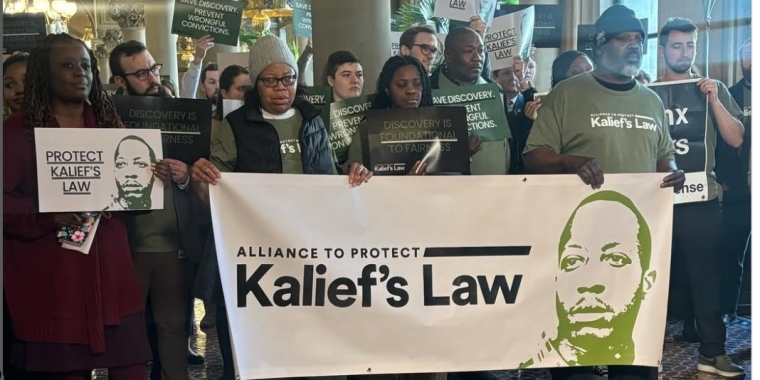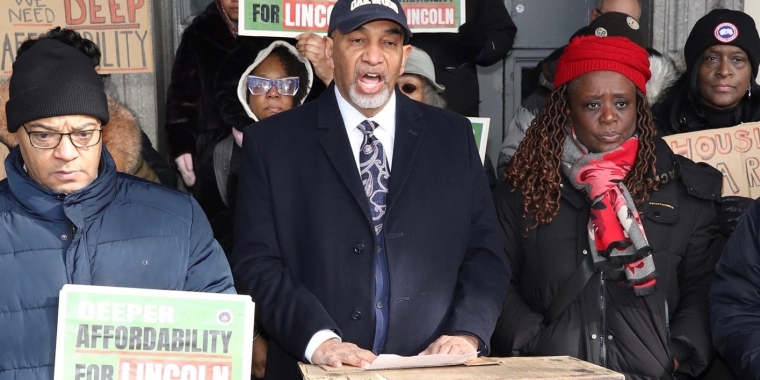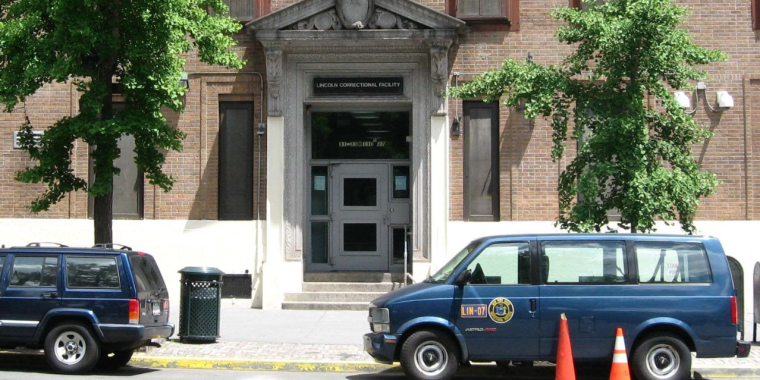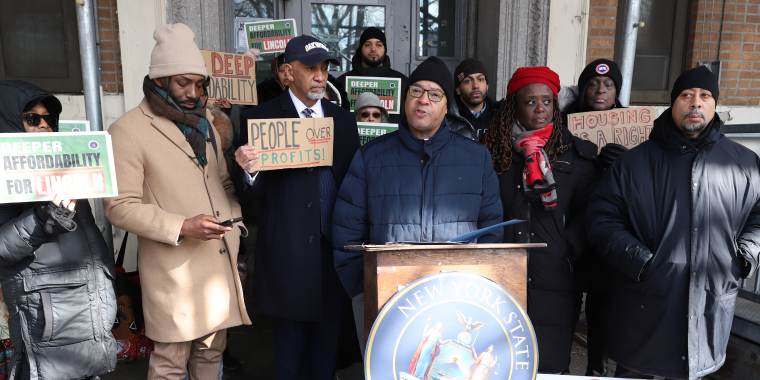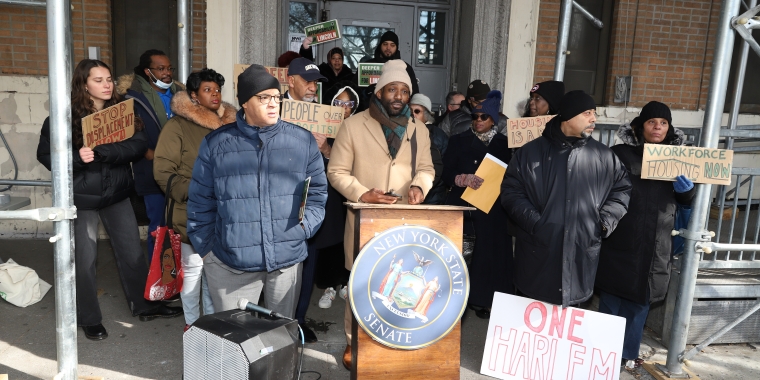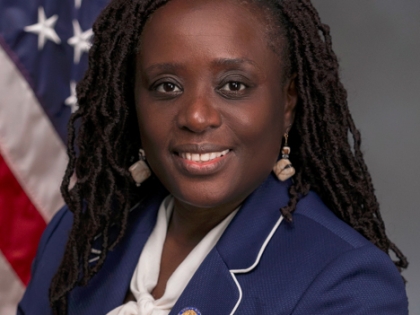
Senator Cordell Cleare, Assemblymember Eddie Gibbs, and Councilmember Yusef Salaam Demand Deeper Affordability within the Proposed Lincoln Correctional Facility Redevelopment
February 20, 2025
-
ISSUE:
- Housing Equality
- Aging (6711

HARLEM, NEW YORK— on February 20th, 2025, Senator Cordell Cleare, Assemblymember Eddie Gibbs, and Councilmember Yusef Salaam hosted a rally in front of the Former Lincoln Correctional Facility to demand the redevelopment project be halted until increased affordability is promised. The elected officials are joined by Community Board 10, Pastor Dedrick Blue from the Interfaith Commission for Housing Equality, and many other community, faith-based, and tenant leaders.
New York City’s housing crisis is of primary importance, especially in rapidly gentrifying communities like Harlem and East Harlem. As the legislators representing the former Lincoln Correctional Facility, the rally's speakers expressed their concerns about the level of affordability promised in the proposed redevelopment. The proposed new development now titled “The Seneca” promises over 100 home ownership, co-op style units with income caps split between 80% AMI and 100% AMI. This would equal monthly payment rates for a 2-bedroom apartment at $3000 dollars a month for those under 80% AMI and $3700 a month for those under 100% AMI. These costs would be $36,000 and $44,400 for housing costs, in addition to down payments. The costs of these apartments are nowhere near affordable for the residents of my district.
According to US census data collected in the American Community Survey in 2023, the median income for a Black household in zip code 10026 where ‘The Seneca’ will be located is $53,666. In the current plan for the Seneca, a Black family in Harlem would need to earn more than double the amount of the median income in order to not live rent burdened in a two-bedroom apartment. The displacement of Black New Yorkers did not end with Seneca Village in 1857, it is happening increasingly every day, especially in Harlem. The population of zip code 10026, which includes Central Harlem between 110 and 120th streets, was 54% Black in 2010 but in 2020 that number fell to just 42%. The speakers came together to urge the ESDC to halt its development of the Lincoln Correctional Facility until increased affordability is provided.
“It is gut wrenching,” said Senator Cordell Cleare, “to see that Harlem, which has defined Black culture for over a century, is no longer affordable to its residents. I am stopped everywhere in my district by residents facing housing insecurity and those who were forced to move elsewhere in the city because they cannot afford Harlem anymore. Children of families that have lived in Harlem for generations go off to college and are stuck with nowhere to live upon their return, because of the skyrocketing prices. We must do everything we can to build truly affordable housing to stop the outmigration of Black and Latino residents across Harlem.”
“As we stand at the crossroads of Harlem's future,” said Assemblymember Eddie Gibbs, “we're faced with a choice: continue down the path of displacement and gentrification or forge a new way that prioritizes community and affordability. We need to ensure that affordable housing remains a cornerstone of our district, providing a sense of security and belonging for long-time residents. The Lincoln project is our chance to redefine what development looks like in our neighborhood, with affordability at its core. We must reject the failed policies of the past, where $1 transfers became get-rich-quick schemes for developers, and instead build a model that uplifts our community and preserves its affordability for all. This isn't just about bricks and mortar – it's about the soul of Harlem. We need to prioritize affordability, community engagement, and cultural preservation in our development decisions. Let's build a future that's rooted in justice, equity, and community power, where everyone has access to affordable housing and the opportunity to thrive.”
“As the City Council Member of Harlem,” said CM Yusef Salaam, “I strongly support efforts to bring more affordable housing to our city, especially in areas where the need is so great. However, we must acknowledge that the current plans for this development fall short of truly addressing the affordability crisis that many of our long-term residents face. I am deeply concerned that, without ensuring housing that is truly affordable, we risk pushing out the very people who have built and sustained this community for generations. These are the families, workers, and neighbors who have made this area vibrant and unique. If we allow gentrification to sweep through unchecked, we could lose the heart and soul of our community. It is vital that we find a way to create new opportunities without displacing the people who have made this place home. We need to prioritize those who need it most and ensure that every resident has a place in the future of this city.”
“With Harlem being considered a high displacement risk area,” added Manhattan Community Board 10 First Vice Chair, Charles Johnson, “this project would further exacerbate the underlying issue of a lack of affordable housing in our community. The monthly cost of this project’s units presented will exclude many local residents from accessing units, reinforcing the existing racial income disparities here in Harlem. Central Harlem is near neighborhoods with high market pressure scores. We are already seeing how this proximity is accelerating gentrification trends as higher- income residents move into the area which drives up housing costs while displacing lower income residents. Displacement in Harlem has already led to significant demographic shifts to our historically rich community. As a community, we should not accept this and demand for better conditions to preserve our rich culture.”
“The Lincoln Correctional Facility” said Pastor Dedrick Blue, Vice Chairman of the Interfaith Commission for Housing Equality, “is a state-owned building that does not have a profit burden, therefore the project should be deeply affordable, starting at minimum wage. The Empire State Development Corporation was not elected by members of the community and should not have the power to dictate the future of a neighborhood whose residents are being displaced at alarming rates. This development (at these rates) will mark the end of Harlem. Harlem is not obligated to ensure a return on investment to developers. The community must not support developments that provide for a modicum of affordable units at the consequence of soaring rents and mass displacement. Letting this development go through would set a bad precedent for the One45 and Lenox Terrace projects and future Harlem developments.
Sen. Cleare, AM Gibbs & CM Salaam are joined by Harlem leaders to demand affordability at Lincoln. No more Displacement!
Share this Article or Press Release
Newsroom
Go to NewsroomNew York Discovery Law Debate Heats Up
March 4, 2025

Pushback grows to Hochul's proposed discovery changes
March 4, 2025
